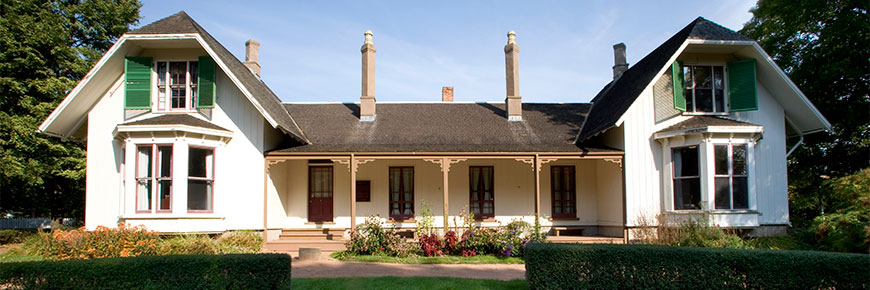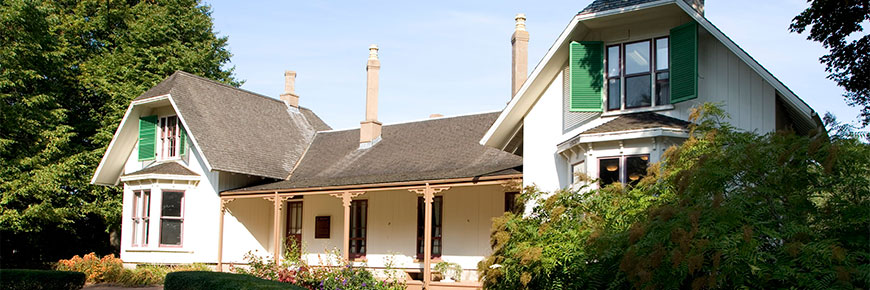
Culture and history
Ardgowan National Historic Site
Former home of a Father of Confederation
William Henry Pope, 1825-1879
William Henry Pope was born in 1825, the son of another prominent Island politician, Joseph Pope. He was educated in Charlottetown and later studied law in London, England. As a lawyer, land agent, journalist, and politician, Pope was a colourful and significant figure in Island life. After the victory of the Conservative Party in 1859, he was named colonial secretary and also became editor of the Islander newspaper.
Imbued with the spirit of nation building, Pope was named as a delegate to the Charlottetown Conference at Province House in September 1864, thus becoming immortalized as a Father of Confederation. Although the general mood of Prince Edward Island was anti-Confederation, Pope was an adamant proponent of a union of the British colonies in North America.
Eventually, faced with overwhelming public opposition to Confederation, Pope resigned from office in 1866. He left Ardgowan in 1875, and died in Summerside in 1879 while serving as a judge of the Prince County Court.
Ardgowan - The House

Ardgowan is an example of a “picturesque cottage” or cottage ornée, a style once popular as a rural residence. As the home of a prominent politician, Ardgowan was often the scene of dinners and lavish entertaining which was a vital part of Victorian public life.
During the Charlottetown Conference, Pope hosted his fellow delegates to what was remembered as a grand luncheon of “oysters, lobsters, champagne and other Island luxuries.” Life at Ardgowan reflected the family’s secure social position. There were servants, a governess, a horse and carriage as well as a fine library. The sandstone carriage step remains today - a reminder of days gone by.
Ardgowan - The Grounds
“Ardgowan,” the name given to the original 76 acre estate, reflects Pope’s appreciation for the landscape, with “ard” being Highland Gaelic for hill and “gowan” Lowland Gaelic for the common daisy. He was reputed to have been a gentleman gardener and added some of the landscape features still in existence today.
Parks Canada acquired the house and five acres in 1967 to commemorate the role of the Fathers of Confederation in Canada’s history. Ardgowan was restored on the exterior following extensive historical research. An 1880’s photograph shows the house and immediate foreground, including the circular ash drive with its stone edging and the circular hedge. The enclosed croquet lawn and seating around the vinecovered stump are visible in an oil painting from 1888. Archaeological probes helped to define the basic layout of the grounds and provided specific location of the driveway and garden areas.
Today, a walk through Ardgowan is a glimpse of tranquil Victorian life, sheltered from the city sights and sounds by the re-establishment of perimeter hedges. Huge linden and oak trees cast an ethereal shade on expansive lawns once cut by a scythe and winding gravel paths pass by curving beds of flowers and shrubs, their scents hanging in the air.
The verandah of Ardgowan looks out upon the only formal area of the grounds; a lawn encircled by privet and euonymus hedge with a centerpiece bed of Rosa rubrifolia, geraniums and begonias. Beyond this was the croquet lawn where adults and children alike played this most popular game.
The north side of the property is the utilitarian area of the estate. Here, set apart by a white picket fence and screened from view by a wooded area, the routine chores of Victorian life were performed. The trees in the orchard bear the apple varieties popular in the 1860’s. To the west of the barn, a kitchen garden could be seen at the time, including not only vegetables but also some of the small fruits used in homemade preserves; raspberries, gooseberries and currants. Rather than our modern method of “row” planting, these period vegetables were planted in blocks and supported by structures of stick and twine.
In order to preserve this living museum, the restoration of Ardgowan’s landscape is a continuous process. Regular replanting of heritage species ensures its future existence and the maintenance practices reflect the period; close cropped, weed free lawns are avoided at Ardgowan just as modern varieties of roses and flowers are banished from the gardens.
Today, the interior of the building is very different from during W.H. Pope’s time. Offices, not bedrooms, fill the house. No preserves are in the basement, nor are there cows in the barn. Ardgowan stands as a reminder of the Island’s past political and societal history and of the man who envisioned the birth of Canada and Prince Edward Island’s place in the new dominion.
Related links
- Date modified :
